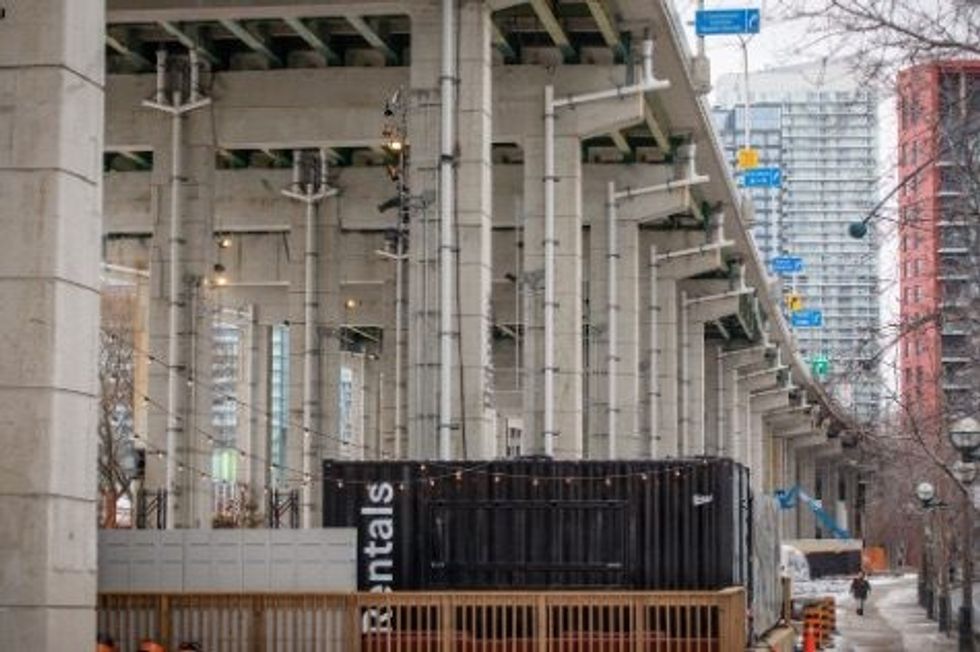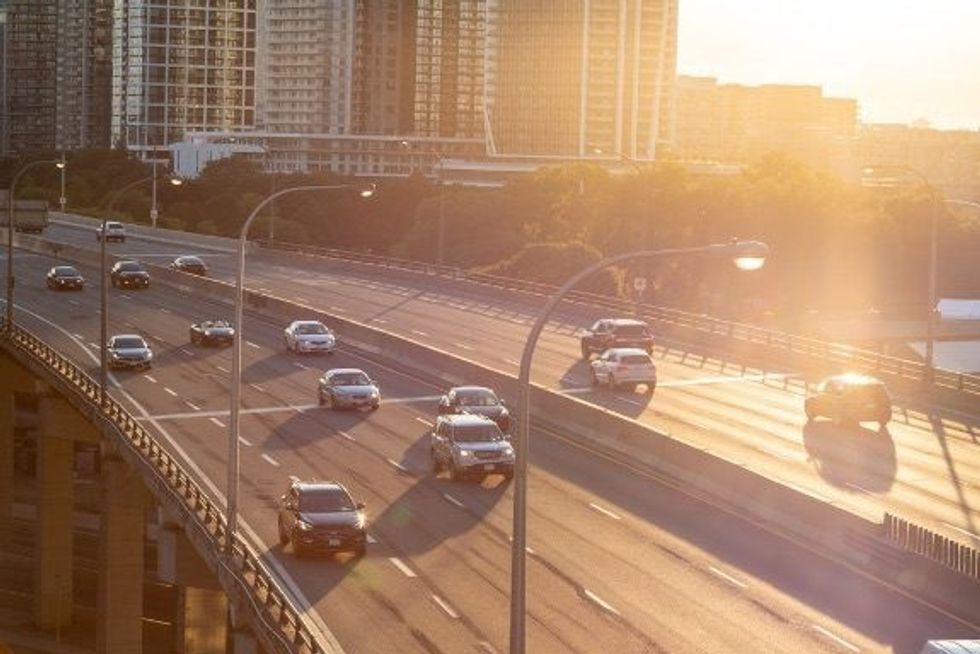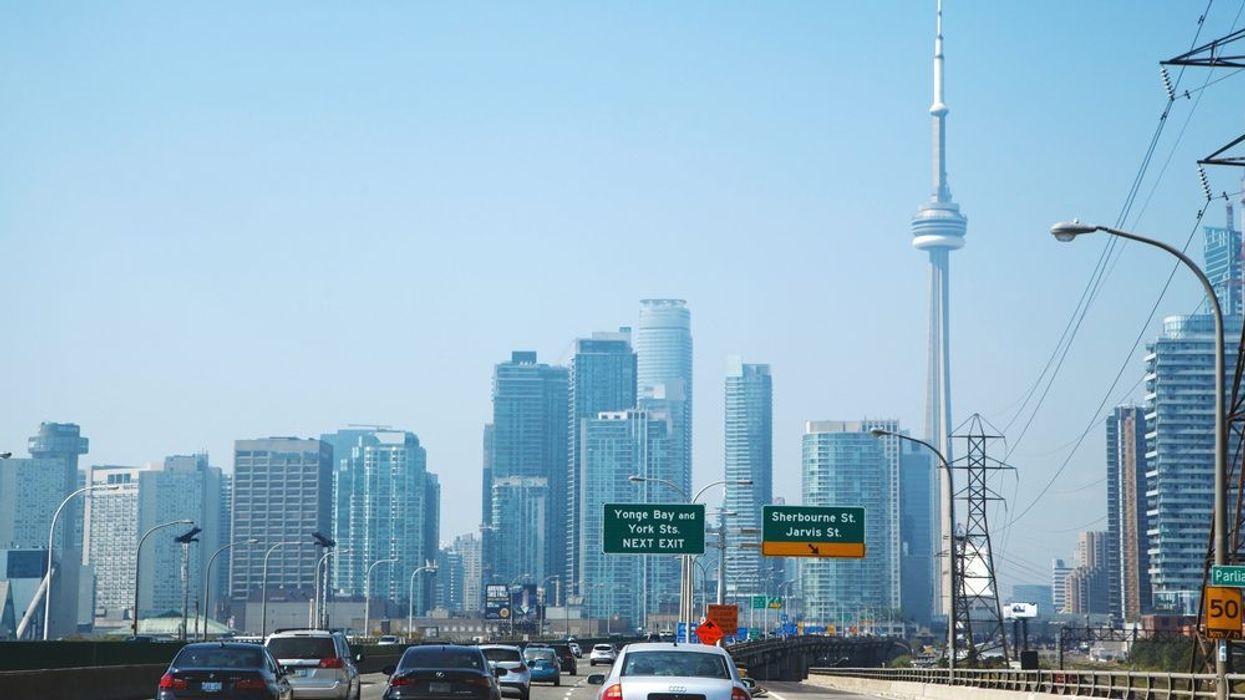Toronto’s infamous Gardiner Expressway has been the subject of both ridicule and debate for decades.
The partially elevated urban expressway was completed in 1965 and runs close to the shore of Lake Ontario, from the foot of the Don Valley Parkway (DVP) in the east, to the junction of Highway 427 and the Queen Elizabeth Way (QEW) to the west. This includes prime real estate in the oldest parts of downtown Toronto, where the highway is the unofficial longest bridge in Ontario (a fun fact to tell out-of-town friends).
Despite the vibrant repurposing of some of its shadowed underbelly with the arrival of the celebrated public space initiative The Bentway in 2018, the elevated highway has always dauntingly separated the city from Lake Ontario -- and likely always will. For a city that sits on a stunning Great Lake, this divide renders a visit to the waterfront an afterthought for countless residents who live and work north of the highway.
The often intimidating eyesore factor that dissuades pedestrians from walking underneath it is only one problem with the aging infrastructure, which is owned and operated by the City of Toronto. Thanks to its limited capacity, the highway is notorious for its traffic jams, which are a daily occurrence. Some summer evenings -- when, say, a Blue Jays game, a festival, and a Budweiser Stage concert all fall at the same time (***shudder***) -- it could take an hour to get across the city core. But, more alarmingly, the Gardiner definitely isn’t in its prime anymore and it’s no secret that it’s literally crumbling before our eyes, with well-documented incidences of falling concrete.

It seems nobody was ever that thrilled with the highway; modifications to the Gardiner Expressway have been the topic of passionate debate since the '80s. In 1987, a comprehensive study of potential changes to its ramps in the downtown area, titled the Central Bayfront Ramp Study, was conducted. To date, only the 2017 removal of the southbound Yonge Street to eastbound Gardiner Expressway ramp has been implemented.
In 1990, The Royal Commission on the Future of the Toronto Waterfront suggested the removal of the entire elevated Gardiner Expressway and its replacement with a network of tunnels and surface roads. In 2001, the removal of a 1.3-km section of the Gardiner Expressway East of the Don River, between Bouchette Street and Leslie Street, was completed at the cost of $38M.
In 2015, Toronto City Council rejected the idea of demolishing the 1.7-km stretch of the highway between Cherry Street and the DVP, voting instead for a hybrid model in 2016. The two alternative options involved repairing that section of Gardiner or tearing it down and replacing it with a boulevard. The hybrid rebuild model involves re-aligning the elevated highway northeast of Jarvis Street, between Cherry Street and the DVP. The Gardiner on/off ramps to Logan Avenue are now removed. Work started on the Lake Shore Bridge over the Don River and Lake Shore Boulevard East from Don Roadway to Carlaw in February 2022.
Recently, the Gardiner conversation picked up traction ahead of an Executive Committee debate earlier this month when Gardiner East Transparency -- a coalition comprised of some 40 concerned neighbourhood groups -- released a letter in advance of the debate that called on City of Toronto councillors to authorize a report investigating costs of the project and lost revenues by continuing the rebuild. The committee, however, wasn’t having it. Despite hearing the case for a change of direction in the project, the City revealed that nearly half of the project’s $1B budget had been spent, and the report was ultimately shelved.
It’s definitely not the last we’ll hear it, however. Rebuilding the Gardiner East has become a hot campaign issue in the upcoming mayoral election, with the race officially kicking off on April 3. The always vocal Councillor Josh Matlow wants to revisit the decision to rebuild the highway, and has said that a surface level boulevard would be a more effective solution. Swapping an elevated highway for an at-grade road could allow for the construction of thousands of new housing units and save millions of much-needed municipal dollars that could be redirected to other pressing needs, he says.
Matlow has even suggested that Toronto will become the subject of ridicule if it moves forward with what he thinks is an outdated idea to rebuild an elevated highway. And perhaps he’s not wrong. Nonetheless, others think we should see the project through.
Mayoral candidates like Planning and Housing Committee Chair Brad Bradford and former deputy mayor Ana Bailão want to stick to the plan, as do current Deputy Mayor Jennifer McKelvie and Councillor Stephen Holyday.
Albert Koehl, Spokesperson for the Gardiner East Transparency, is still calling for a fully updated report from the City of Toronto, noting that the coalition's focus is on the Cherry Street to DVP section of the expressway. “Our demand was simple; namely, a report on the updated construction costs, foregone revenues (from land that could be freed up), and feasible design alternatives to the plan approved by a previous council in 2015,” Koehl tells STOREYS. “The report would be timely since major contracts for the rebuild have yet to be tendered.”
Koehl highlights how the actual reconstruction of what he calls “the colossal, elevated Gardiner-DVP” won’t start until 2026. And it certainly won’t come cheap, says Koehl, as he outlines the figures.
“The Gardiner relocation and rebuild will cost about $500M (plus the value of land -- about 5.4 acres --- that could be sold and from which revenues could be generated from property taxes) at a time when the city has a $1.5B budget deficit and its policies include reducing car dependency to meet our green house gas reduction goals,” says Koehl. “In addition, the rebuilt expressway will compete for customers with shovel-in-the-ground transit projects, including the Ontario Line.”
In response to recent questions raised by Matlow regarding updated cost estimates, city staff have said that, indeed, $500M has been spent on parts of the Gardiner project already completed or under construction. The cost for the reconstruction of the elevated portion comes with a $450M price tag.
“A report, given the massive cost of the rebuild and changed circumstances since 2015, simply constitutes the exercise of due diligence and prudent financial management among municipal decision makers,” says Koehl “If we are to have an informed debate on the future of the Gardiner, then we need to get the facts. The new Gardiner-DVP link is projected to last 100 years, and therefore constitutes spending that will lock us into the Gardiner, and further spending, far beyond the actual need for such infrastructure.”

McKelvie, however, sits firm in her stance not to change course right now. "We cannot keep having the same conversations about decisions that have been made seven years ago,” McKelvie tells STOREYS. “The City of Toronto has already spent hundreds of millions of dollars on this project. The Gardiner Expressway is over 60 years old and is in a poor state of repair. It needs renewal. Changing course now is expected to save no money, possibly cost more money, and result in throwaway costs of $340M (for the section already completed).”
Not to mention, McKelvie says the City simply can’t afford to switch up the plan.
“City staff have said that even if the longstanding decision was reversed, there would be no funds to redirect for other purposes, and delays would result in additional costs, for example, additional interim repairs, escalated construction costs, and reopening the Environment Assessment process,” says McKelvie. “I support moving forward with the project."
Councillor Holyday also agrees that the City should continue to execute the rehabilitation plan decided upon in 2015 -- and that questioning the move is making Toronto look bad, frankly. “The City has suffered reputational damage from the political instability demonstrated by second guessing this key infrastructure decision,” Holyday tells STOREYS. “Uncertainty like this harms economic development and undermines our ability to attract and retain business and employment within the City who rely on the Gardiner Expressway.”
Like McKelvie, Holyday says the cost of not moving forward would be greater than doing so. “As shown in past reports from the Auditor General, there is room to improve how the City manages contracts,” says Holyday. “However, escalating construction costs should be weighed against the value of time lost to congestion and the harm posed to the economy. If Council was genuinely interested in cost, it would review the Fair Wage Policy which voluntarily inflates the price of public works across the City.”
Holyday points to recent reports that indicate that Toronto is the third most congested city in North America. “Contributing $1B annually to Canada's economy, the Gardiner Expressway is vital infrastructure for goods movement, services and freedom of movement for citizens. It defies logic to deliberately cause more congestion, and the essential role the Gardiner Expressway plays in services and the economy cannot be ignored.”
Koehl is still hopeful for a report now that the "great Gardiner debate" is central to the mayoral election. “We believe the public cares very much, based on the extent of media coverage on our recent initiative,” says Koehl. “It is a divisive issue, but an informed debate requires facts, as we have demanded in the call for a report. The report itself was not granted by a recent meeting of the Infrastructure and Environment Committee, chaired by the Acting Mayor, but the mayoral election presents another opportunity to demand and to get such a report.”
In the meantime, love it or hate it, the one positive thing the Gardiner does offer is incredible views of the cityscape -- whether you’re driving in from the east or west. So, at least there’s that.





















